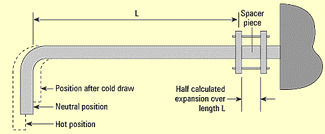 |
Satish Lele lelepiping@gmail.com |
View this page as YouTube Video Presentation
The amount of movement to be taken up by the piping and any device incorporated in piping can be reduced by 'cold pull'. The total amount of expansion is first calculated for each section between fixed anchor points. The pipes are left short by half of this amount, and stretched cold by pulling up bolts at a flanged joint, so that at ambient temperature, the system is stressed in one direction. When warmed through half of the total temperature rise, the piping is unstressed. At working temperature and having fully expanded, the piping is stressed in the opposite direction. The effect is that instead of being stressed from 0 to +1 units of force, the piping is stressed from -1/2 to + 1/2 units of force.
In practical terms, the pipe work is assembled cold with a spacer piece, of length equal to half the expansion, between two flanges. When the
pipe work is fully installed and anchored at both ends, the spacer is removed and the joint pulled up tight.

 to get all the information as a eBook
to get all the information as a eBook
